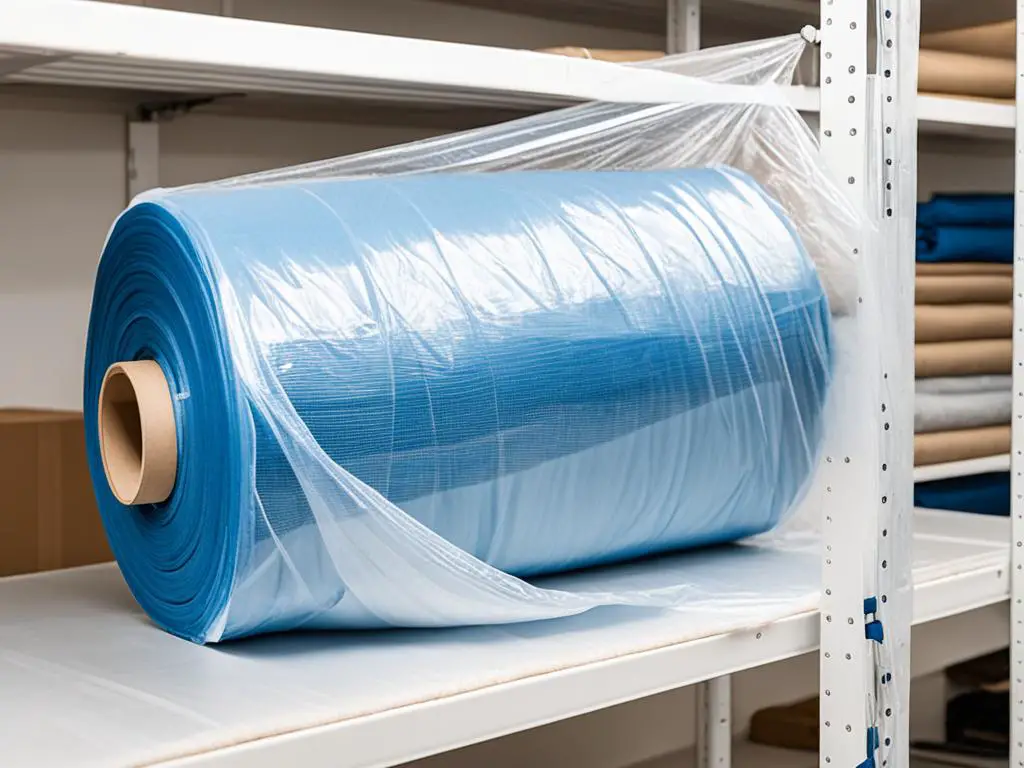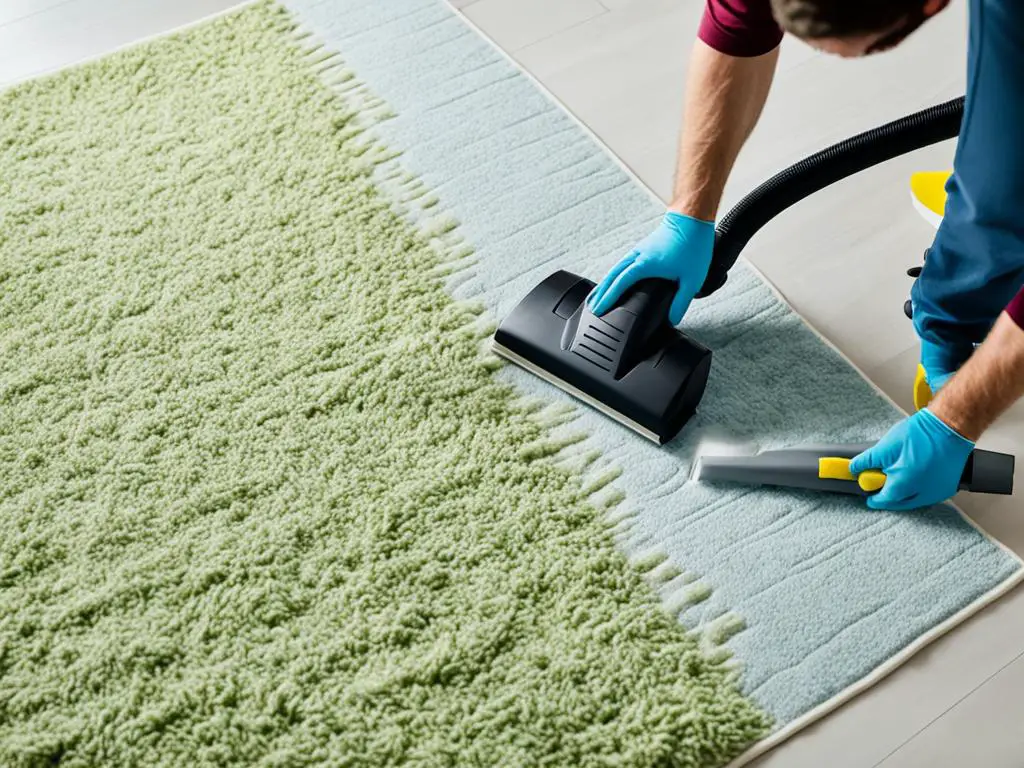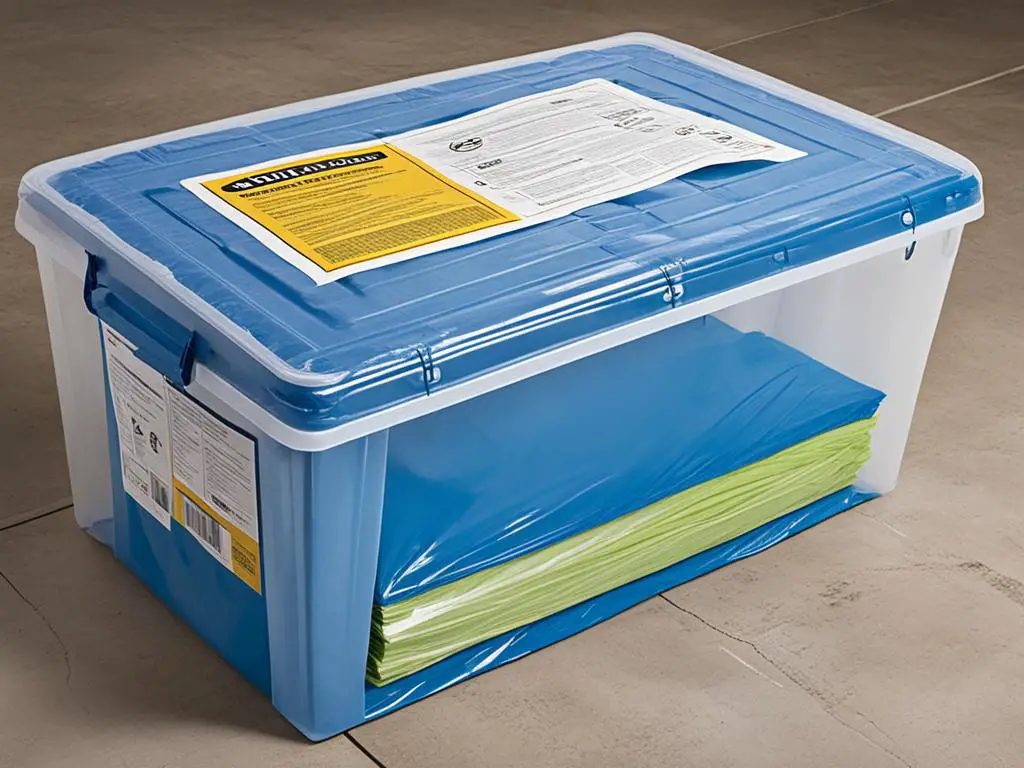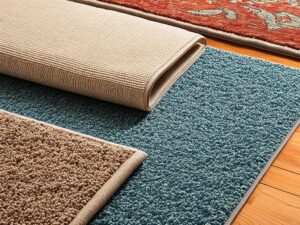Storing rugs properly is essential for preserving their beauty and quality, particularly when storing them long-term. Improper storage can lead to damage, loss of shape, pest infestation, and unwanted odors. By following the right rug storage tips and techniques, you can ensure that your cherished floor coverings stay in pristine condition for years.
Key Takeaways:
- Proper rug storage is crucial for maintaining the beauty and quality of your rugs over the long-term.
- Improper storage can lead to damage, loss of shape, and pest infestation.
- Follow rug storage tips and techniques to ensure your rugs stay in pristine condition.
- Protect rugs from pests and moisture by using appropriate repellents and breathable wrapping materials.
- Thoroughly clean rugs before storage to remove dirt and debris.
Should You Roll or Fold a Rug?
When it comes to storing rugs long-term, one common dilemma is whether to roll or fold them. While folding might seem like a convenient option, it can actually lead to detrimental effects on the rug’s condition over time. To preserve your rug’s beauty and prevent damage, it is recommended to roll your rugs instead.
Folding a rug can cause creases, cracks, and permanent damage to the rug fibers. This is especially true for delicate or valuable rugs, as the pressure applied during folding can weaken the fibers and compromise their integrity. By rolling your rug into an even cylinder, you not only protect it from potential damage but also make transportation and storage much easier.
Rolling rugs for storage also allows for optimal space utilization. Whether you’re storing your rugs in a closet, under a bed, or in a dedicated storage unit, rolled rugs take up less space compared to folded ones. This can be particularly beneficial if you have limited storage space or if you’re storing multiple rugs.
However, it is important to note that for smaller rugs that need to be stored in drawers or shelves, folding may be necessary. In such cases, it is essential to avoid sharp creases that can permanently damage the rug. Gently fold the rug without placing excessive pressure on the fibers to minimize the risk of creasing.
Remember:
“Rolling rugs is the preferred method for long-term storage due to its ability to prevent damage and save space.”
To further protect your rug, consider wrapping it in a breathable fabric such as cotton sheets or muslin. This provides a protective barrier against dirt, dust, and pests, while allowing air circulation to prevent moisture buildup. Additionally, storing your rolled rugs vertically rather than horizontally can help maintain their shape and prevent creasing.
By choosing to roll your rugs instead of folding them, you can ensure their long-term preservation and prevent damage to their fibers. Implementing proper storage techniques, such as rolling, wrapping, and storing vertically, will help maintain your rug’s condition and extend its lifespan.
Protecting Rugs in Storage
When storing rugs long-term, it’s essential to take precautions to protect them from potential damage caused by pests and moisture. By following these rug storage tips, you can ensure that your beloved rugs remain in pristine condition for years to come.
Preventing Pest Damage
To prevent pests such as moths and insects from damaging your rugs, it’s important to use appropriate repellents. Look for insect and moth repellents specifically designed for fabrics, as they are safe to use on rugs. Apply the repellents according to the manufacturer’s instructions before storing the rugs.
Avoiding Moisture Buildup
Mold and mildew can wreak havoc on stored rugs, so it’s crucial to prevent moisture buildup. Avoid wrapping rugs in plastic, as it can trap moisture and create a breeding ground for mold. Instead, opt for breathable fabric covers like cotton sheets or muslin. These materials provide a protective barrier against dust, dirt, and pests while allowing airflow to prevent mold growth.
Proper Storage Environment
The storage environment plays a vital role in rug preservation. It’s recommended to store rugs off the ground to protect them from potential water damage and pests that may reside on the floor. Elevate the rugs on pallets or shelves to keep them safe and dry.
Additionally, choose a cool and dry storage area to minimize the risk of mold and mildew. Avoid storing rugs in damp basements or humid attics, as these conditions can lead to irreversible damage. Consider using climate-controlled storage units that regulate temperature and humidity levels for optimal rug preservation.
Regular Inspection and Maintenance
Even while in storage, rugs require periodic inspection and maintenance. Regularly check for any signs of pest activity, such as moth larvae or insect eggs, and take immediate action if detected. It’s also essential to keep the storage area clean and free from debris to prevent pests from establishing themselves.

Cleaning Rugs Before Storage
Before storing rugs for the long term, it’s crucial to clean them thoroughly to remove dirt, debris, and potential allergens. Proper cleaning not only helps maintain the rug’s condition but also prevents pests from infesting the stored rugs.
The first step in cleaning rugs before storage is vacuuming. This process lifts dander, dust, and microscopic particles from the rug’s surface and fibers. However, it’s essential to exercise caution when vacuuming valuable or delicate rugs to avoid any damage. Adjust the vacuum settings to a gentle mode and use a soft brush attachment to prevent excessive agitation.
“Thoroughly cleaning your rugs before storage helps maintain their condition and prevent pest infestation.”
Cleaning methods may vary depending on the rug material, so it’s important to refer to the manufacturer’s instructions. Different types of rugs have specific cleaning recommendations:
- Woven or Braided Rugs: These rugs can usually tolerate gentle machine washing or handwashing. However, always check the care label of the rug for specific instructions.
- Handmade or Antique Rugs: These valuable rugs require extra care when cleaning. It’s best to entrust their cleaning to professional rug cleaners who specialize in handling delicate and antique rugs.
- Oriental Rugs: Oriental rugs are often made of delicate fibers and dyes. It’s recommended to have them professionally cleaned to ensure their preservation.
- Natural Fiber Rugs: Rugs made from natural fibers such as jute, sisal, or seagrass should be dry cleaned or spot cleaned as per the manufacturer’s recommendations.
“Different types of rugs require different cleaning techniques – always follow the manufacturer’s instructions.”
By following the appropriate cleaning methods based on the rug’s material, you can ensure that your rugs are free from dirt, debris, and potential allergens, promoting a healthier indoor environment. Clean and well-maintained rugs are less likely to attract pests and will stay in excellent condition during long-term storage.

Proper Rug Storage Techniques
To store rugs properly for long-term storage, it’s important to follow specific techniques to maintain their shape and quality. Here are some rug storage tips to ensure your prized rugs stay in excellent condition:
1. Storing Rugs Vertically
When storing rugs, always store them vertically. This helps maintain their shape and prevents any warping or distortion. Prop them up in a corner to prevent toppling and keep them away from heavy items that could cause damage.
2. Using Climate-Controlled Storage
Investing in a climate-controlled storage unit is highly recommended for rug storage. Controlling temperature and humidity levels helps prevent mold and mildew growth, which can cause irreversible damage to rugs.
3. Maintaining Rug Shape
To maintain the shape of your rugs, it’s essential to take a few precautions. Elevate the rug off the ground using pallets or wooden boards to provide airflow and prevent potential moisture damage. Avoid placing heavy items on top of the rug, as this can lead to compression and deformation.
4. Consistent Cleaning and Maintenance
Regular cleaning and maintenance are crucial to prevent insect infestation and keep your rugs in good condition while in storage. Vacuum the rugs regularly to remove dust, dirt, and debris. Dusting the rugs and implementing a housekeeping plan will further minimize the risk of pests.
By following these rug storage techniques, you can ensure that your rugs stay well-preserved and ready to be enjoyed when you retrieve them from storage.

Rug Storage Techniques
| Rug Storage Techniques | Description |
|---|---|
| Store rugs vertically | Prevents warping and distortion |
| Use climate-controlled storage | Controls temperature and humidity to prevent mold and mildew growth |
| Maintain rug shape | Elevate rugs off the ground and avoid placing heavy items on top |
| Consistent cleaning and maintenance | Regular vacuuming, dusting, and implementing a housekeeping plan |
Conclusion
Properly storing rugs is crucial for maintaining their beauty and ensuring their longevity. By following these rug storage tips and techniques, you can keep your rugs in excellent condition while in storage. Thoroughly cleaning the rug before storage is essential to remove dirt and debris that can cause damage over time.
Protecting rugs from pests and moisture is another important step in long-term rug storage. Using appropriate insect repellents and wrapping the rug in breathable fabric can prevent insect infestation and mold growth. Storing rugs vertically in a climate-controlled environment helps maintain their shape and prevents damage from heavy items.
By implementing these long-term rug storage solutions, you can ensure that your rugs remain in optimal condition. Take the necessary precautions to preserve their beauty and extend their lifespan. With proper care and storage, your rugs will be ready to enhance your space whenever you decide to bring them out of storage.



